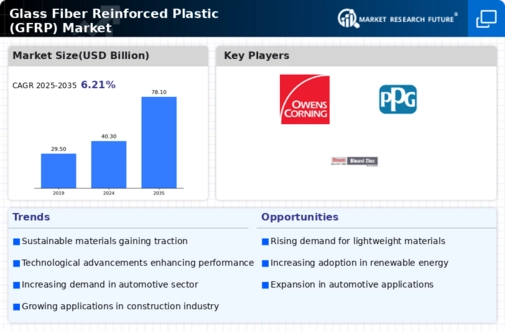Market Trends
Key Emerging Trends in the Glass Fiber Reinforced Plastic GFRP Market
The market trends of Glass Fiber Reinforced Plastic (GFRP) are influenced by various factors, including technological advancements, environmental regulations, economic conditions, and industry demand. GFRP, also known as fiberglass, is a composite material made of fine glass fibers reinforced with a polymer matrix, typically epoxy or polyester resin. One of the key trends in the GFRP market is the growing demand for lightweight and high-strength materials across various industries such as automotive, construction, aerospace, and marine. GFRP offers significant advantages over traditional materials like steel and aluminum, including corrosion resistance, durability, and design flexibility.
Increase in urbanization with expansion in wealth steers up the growth of glass fiber reinforced plastic market during the glass fiber reinforced plastic forecast period. Transportation increases the market volume and glass fiber reinforced plastic market value. If the manufacturing of the equipment costs low at low cycle time then surely an increase in glass fiber reinforced plastic market size takes place. It has been widely used in the electrical and electronic industry.
In recent years, there has been a noticeable shift towards sustainable and eco-friendly materials, driven by increasing environmental concerns and stringent regulations. GFRP fits well into this trend as it is recyclable and consumes less energy during production compared to traditional materials. This sustainability aspect has led to a rise in the adoption of GFRP in green building projects, infrastructure development, and renewable energy applications like wind turbine blades and solar panels.
Another significant market trend is the growing use of GFRP in the automotive sector, particularly in the production of lightweight components to improve fuel efficiency and reduce emissions. Automakers are increasingly incorporating GFRP into vehicle design to meet stringent fuel economy standards and enhance performance. Additionally, GFRP offers design flexibility, allowing manufacturers to create complex shapes and contours that are not feasible with traditional materials.
The construction industry is also a major driver of the GFRP market, with the material being used in a wide range of applications such as bridges, buildings, pipes, and reinforcing bars. GFRP's high strength-to-weight ratio, corrosion resistance, and durability make it an ideal choice for infrastructure projects, especially in harsh environments where traditional materials may deteriorate quickly. Moreover, GFRP's ability to withstand seismic activity and harsh weather conditions makes it a preferred option for resilient and sustainable construction.
In the aerospace and marine sectors, GFRP is valued for its lightweight properties and high strength, which contribute to fuel efficiency, performance, and durability. Aircraft manufacturers use GFRP composites in structural components, interiors, and engine parts to reduce weight and improve fuel economy. Similarly, boat builders utilize GFRP for hulls, decks, and other components to enhance buoyancy, speed, and corrosion resistance.
However, despite its numerous benefits, the GFRP market faces challenges such as cost competitiveness, processing limitations, and concerns about recyclability and end-of-life disposal. The initial investment in GFRP materials and manufacturing processes can be higher than traditional materials, which may deter some manufacturers from adopting them. Additionally, the recycling and disposal of GFRP products present logistical and environmental challenges, although efforts are underway to develop more sustainable solutions.







Leave a Comment